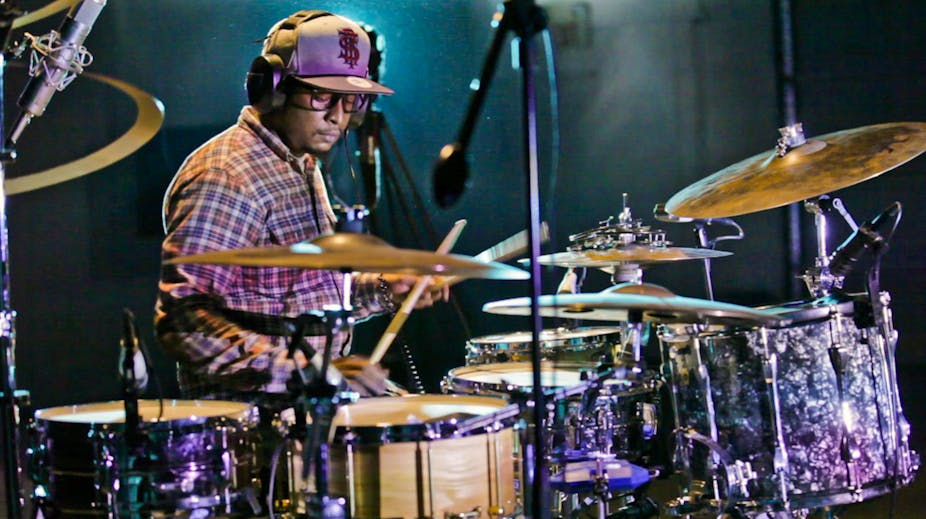Jazz has evolved to become one of the most inclusive genres in modern music. But how does an art form that so willingly assimilates influences from different musical styles still hold on to its essence?
For many contemporary musicians, improvising with disparate influences is the key to their authentic jazz identity. The great American jazz pianist Bill Evans said in 1966:
Jazz is not so much a style as a process of making music.
Two musicians appearing at the Melbourne International Jazz Festival this weekend, American drummer Chris Dave and Spanish flautist/ saxophonist Jorge Pardo, embody this concept of jazz-as-process and exemplify the way non-jazz influences emerge in contemporary improvisation. We’ll come back to them in a second.
For Evans, “jazz” was a verb, a means of spontaneous musical composition, rather than a strict set of aesthetic guidelines – the walking bassline, swinging cymbal pattern and blues-inflected melodies that American jazz musician Wynton Marsalis has insisted upon.
Marsalis’ formula represents the tradition inherited from the music’s great innovators. All jazz musicians learn and respect this tradition. It is seen as a moral obligation that even the most experimental or idiosyncratic musician should know their history.
But for the 21st century jazz musician making music in a globalised culture this “straight-ahead” style is not something to be recreated. It is a starting point for an individual creative journey that reflects a more inclusive worldview.

Houston native Chris Dave is one of the most in-demand and respected drummers of his generation, remarkable for having not only played all the modern genres of music but having genuinely mastered them. Even if his name is new to some listeners, a glance at his CV makes it clear they would have almost certainly heard his playing.
With his own group, The Drumhedz, his abundant experience is absorbed into a musical bloodstream in which rhythms and styles commingle and flow together.
He describes his influences as “everyone I ever came across”, and indeed Dave does seem to have internalised every piece of music he has ever heard. With an almost forensic sensitivity, he understands the minute details that give drumming styles their unique flavours: the eager, ahead-of-the-beat kick drum of 90s hip-hop; the distended swagger of pioneering producer J-Dilla; the streetwise crackle of 70s breakbeats or the bristling, kinetic propulsion of Tony Williams’ modern jazz.
Moment to moment Dave can conjure scenes from his musical history with the slightest suggestion and draw connections across 70 years of American music. The effect is like a DJ layering and remixing from a vast record collection.
Despite this broad appetite, there is no sense of pastiche or a winking, ironic “mash-up”, but something much more subtle and exciting. This is jazz at its most omnivorous: whole worlds of music are enveloped and then emerge, natural and flowing, in improvisational streams of consciousness.
While Dave repurposes his subjects and manipulates their elements, Spanish flautist/ saxophonist Jorge Pardo paints his influences more faithfully, albeit with his own unique colour.
With guitarist Paco de Lucia throughout the 70s and 80s, Pardo brought jazz-style improvisation and new instrumentation to folkloric forms, creating a revolution in flamenco music.
Pardo’s new group Huellas improvises with flamenco’s distinctive harmony and rhythmic cycles. Unlike Dave’s fragmented evocations, Pardo is more directly imitative of his inspirations, but in the musical translation a new and unique style emerges.
Pardo’s saxophone mimics the rough timbre and delivery of a flamenco singer’s brandy-throated cry, his improvised melodies thick with the Arabic ornamentation that connects the Spanish gypsy to the Moor. In a rendition of a Tarantas by the legendary flamenco singer Camaron de la Isla, Pardo’s flute refracts and echoes the voice of the great cantaor and draws from its essence an improvised cadenza that sounds at once distinctly individual and deeply authentic.
Jazz at its most essential is autobiography, the individual artist’s point of view. At the heart of 21st-century jazz musicians there is a reverence for the traditional form, but also a willingness to change, abandon or lovingly dismantle it if necessary, to find new modes of personal expression. To reflect the world around them and build on what they inherited.
For many this motive is the most sincere way to honour the tradition of jazz, to emulate the spirit of the great innovators rather than attempt to recreate their music.
Chris Dave and The Drumhedz perform at Bennetts Lane Jazz Club on Saturday May 31 and Sunday June 1. Jorge Pardo “Huellas” perform at the Melbourne Recital Centre on Saturday May 31.

